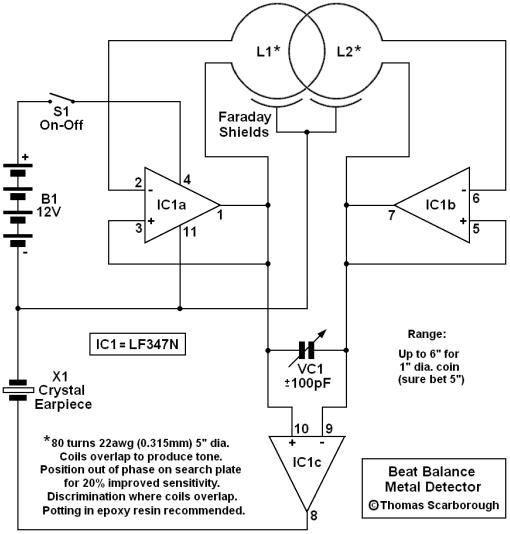Friends,
This concept has met with such popularity (in the last two days I have received e-mails from Poland, USA, Venezuela, England, Denmark, etc.) that I have designed an embodiment especially for the Tech Forum.
You will see that there are two transmitters in the circuit, each comprising only an inductor (search coil) and an op-amp. The frequencies of the two transmitters are mixed through a third op-amp, and fed to a crystal earpiece (or piezo sounder - but then volume will be reduced).
On the surface of it, this would seem to represent nothing more than a twinned BFO detector. However, mutual coupling adds the "balance" of IB, and boosts sensitivity way beyond that of BFO. VC1 is used to obtain a suitable beat frequency or heterodyne (say 200-300Hz).
This is a very simple embodiment of the concept of course, and sensitivity could be boosted significantly beyond that shown with a slightly more complex design. In principle, all that is required is two identical transmitters, a coupling capacitor VC1, and a suitable mixer.
I have dubbed the concept Beat Balance or BB, thus giving a nod to the two genres which underlie it.
With kind regards,
Thomas Scarborough.

This concept has met with such popularity (in the last two days I have received e-mails from Poland, USA, Venezuela, England, Denmark, etc.) that I have designed an embodiment especially for the Tech Forum.
You will see that there are two transmitters in the circuit, each comprising only an inductor (search coil) and an op-amp. The frequencies of the two transmitters are mixed through a third op-amp, and fed to a crystal earpiece (or piezo sounder - but then volume will be reduced).
On the surface of it, this would seem to represent nothing more than a twinned BFO detector. However, mutual coupling adds the "balance" of IB, and boosts sensitivity way beyond that of BFO. VC1 is used to obtain a suitable beat frequency or heterodyne (say 200-300Hz).
This is a very simple embodiment of the concept of course, and sensitivity could be boosted significantly beyond that shown with a slightly more complex design. In principle, all that is required is two identical transmitters, a coupling capacitor VC1, and a suitable mixer.
I have dubbed the concept Beat Balance or BB, thus giving a nod to the two genres which underlie it.
With kind regards,
Thomas Scarborough.


Comment